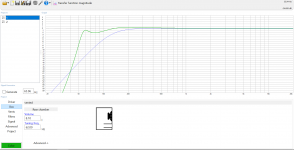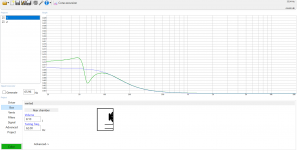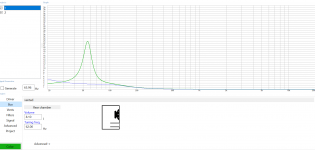Hi, I am currently designing a speaker for my bedroom. I have read many post regarding to speaker compatibility in sealed or closed encosure and saw two different method for calculating it. Some say QTS >0.5 is better for sealed and some say EBP <100 is better for sealed.
My problem lies in the current driver that i own where the QTS is 0.641 but the EBP is 130-ish. My question is, better sealed or ported for my driver in small listening room (bedroom TV)? Keep in mind that the speaker will almost have no gap to the walls (approx. 1-2cm).
I have modeled it on WinIsd, and on the ported enclosure the cone excursion is more than 10mm below tuning frequency (20W Input). Is the WinIsd cone excursion simulator accurate? As i am afraid to damage my drivers via over excursion since i don't know what the Xmax rating of my drivers are.
Help is appreciated, many thanks!
P.S. I attached the driver files obtained via TangBand
My problem lies in the current driver that i own where the QTS is 0.641 but the EBP is 130-ish. My question is, better sealed or ported for my driver in small listening room (bedroom TV)? Keep in mind that the speaker will almost have no gap to the walls (approx. 1-2cm).
I have modeled it on WinIsd, and on the ported enclosure the cone excursion is more than 10mm below tuning frequency (20W Input). Is the WinIsd cone excursion simulator accurate? As i am afraid to damage my drivers via over excursion since i don't know what the Xmax rating of my drivers are.
Help is appreciated, many thanks!
P.S. I attached the driver files obtained via TangBand
Attachments
EBP is a 1st order approximate guideline which attempts to provide a rapid indication what types of load a drive unit is suited to. Personally I regard it as bordering on worthless, since it can lead people right up the garden path, assuming that a driver 'can't' be used in xyz when that is not necessarily the case in practice.
Short version: it doesn't matter what the EBP derivation is if the alignment suits your requirements. The latter is what counts, so if you can hit your desired alignment, job done.
Driver excursion is a completely different matter. A vented box ultimately unloads 4th order (24dB/octave) at some point below tuning, exactly where & how depending on the specific implementation. So if you feed it with material that has a lot of output significantly below Fb, the driver will unload & flap about as though it's in free air (because in essence, it is at those frequencies where it no longer has any air-load from the enclosure). A sealed box is always safer in that sense. You might want to look at a folded TABAQ, it was designed for the TB units, so this one may suit (I haven't time to check right now, but it looks in roughly the ballpark from memory) and should get to to 50Hz. These are all small drivers though, so ultimately a little mechanical sympathy / expectation management (aka common sense) is required: there is only so much air you can shift with a 3in cone, so if you see it moving a large amount, turn the volume down.
Short version: it doesn't matter what the EBP derivation is if the alignment suits your requirements. The latter is what counts, so if you can hit your desired alignment, job done.
Driver excursion is a completely different matter. A vented box ultimately unloads 4th order (24dB/octave) at some point below tuning, exactly where & how depending on the specific implementation. So if you feed it with material that has a lot of output significantly below Fb, the driver will unload & flap about as though it's in free air (because in essence, it is at those frequencies where it no longer has any air-load from the enclosure). A sealed box is always safer in that sense. You might want to look at a folded TABAQ, it was designed for the TB units, so this one may suit (I haven't time to check right now, but it looks in roughly the ballpark from memory) and should get to to 50Hz. These are all small drivers though, so ultimately a little mechanical sympathy / expectation management (aka common sense) is required: there is only so much air you can shift with a 3in cone, so if you see it moving a large amount, turn the volume down.
Last edited:
EBP is a 1st order approximate guideline which attempts to provide a rapid indication what types of load a drive unit is suited to. Personally I regard it as bordering on worthless, since it can lead people right up the garden path, assuming that a driver 'can't' be used in xyz when that is not necessarily the case in practice.
Short version: it doesn't matter what the EBP derivation is if the alignment suits your requirements. The latter is what counts, so if you can hit your desired alignment, job done.
That is true, it's a rough guideline, of what is most likely the best way in general, but not an absolute rule. For me it's what i try to sim first and see if it fits my needs.
And about the bass quality of a 3", it's true that it won't give much bass, for that you need a bigger driver. A 5 or 6" can do a lot more than any 3" on that. I would pair it with a woofer if you want to use this driver and have bass. And the winisd is accurate on xmax and how much bass you get from your driver.
... it doesn't matter what the EBP derivation is if the alignment suits your requirements.
What Scott says. The Qt can give you a ballpark of what the sims will look like but in the end i pay little attention and just look at the shape of the curves i get.
EBP is something i pay zero attention to.
dave
And about the bass quality of a 3", it's true that it won't give much bass, for that you need a bigger driver.
There is only a loose relationship between cone size and how low they can go. I just did a sim for a fellow and one of the 8” he chose would not go any lower than the Alpair 5.2/3. Of course it can move more air and play louder.
dave
So, I sim some more on WinIsd and come up with an enclosure size of 8.1L which give me a QTC of 0.717 in a sealed box. I attached some files of my sim and wanted to ask if the ported is a better way to go or just build a sealed box and just add a sub since it will be easier to implement (12db roll off). Thanks!
Attachments
I have modeled it on WinIsd, and on the ported enclosure the cone excursion is more than 10mm below tuning frequency (20W Input). Is the WinIsd cone excursion simulator accurate? As i am afraid to damage my drivers via over excursion since i don't know what the Xmax rating of my drivers are.
The program is right and yes you can damage the drivers with low frequencies content.
I guess your driver can only swing +/-1 or 2 mm, because of the relativly high efficiency. Similar TB 3" indicate this.
Also the enclosure will be quite large for a reflex, better and cleaner bass with a TL, a target of 100Hz would require a short 75cm line.
Only a closed box wouldn't need a high-pass filter could be small, but has high f3.
If you mount the chassis diagonal in the corner, there would not be any baffle step but even an increase in bass energy(+3dB), maybe your program can simulate this too.
Hoping Planet10 and Scottmoose can contact me re: similar project
Hello,
Thanks for the interesting thread... hope I don't derail it at all. I'm too am looking for a full range single driver enclosure for the TB-1772. But I don't have the technical chops to understand how to translate Hornresp to a real world design. Planet10 and Scottmoose, do you have any interest in a commission to engineer one for me?
Hello,
Thanks for the interesting thread... hope I don't derail it at all. I'm too am looking for a full range single driver enclosure for the TB-1772. But I don't have the technical chops to understand how to translate Hornresp to a real world design. Planet10 and Scottmoose, do you have any interest in a commission to engineer one for me?
I have seen a lot of 3 inch drivers with TL, but for the moment I have not enough resources to build it and TL is quite big. So, which comes next after TL sealed or ported?
a 7l ported with a 23 mm round hole in the 18mm baffle will have a tuning of about 60Hz if the specs you gave are right, but it will very soon run out of xmax as xmax of this kind of driver is mostly 1-2mm. So +5w will hit xmax.
Sealed you will need about 7L following the specs, and then you will have a response to about 95Hz and again run fast to xmax.
Planet10 and Scottmoose, do you have any interest in a commission to engineer one for me?
We can of course do a custom design.
But look at Joan, we have a trapezoid Tan-Ken for them, and Scott may have done an ML-TL already
dave
We can of course do a custom design.
But look at Joan, we have a trapezoid Tan-Ken for them, and Scott may have done an ML-TL already
I'll have a gander -I think I've got one somewhere that I did a while back but didn't take any further.
Too late.
That 1772, what about some baffle step ?
Larryldspkr used 4mh and 10 ohms for a 12" wide cabinet.
Post 398
Tang Band W8-1772 Impressions.
Post 471 (bob brines) and post 478 (larry and baffle step compensation values).
Tang Band W8-1772 Impressions.
That 1772, what about some baffle step ?
Larryldspkr used 4mh and 10 ohms for a 12" wide cabinet.
Post 398
Tang Band W8-1772 Impressions.
Post 471 (bob brines) and post 478 (larry and baffle step compensation values).
Tang Band W8-1772 Impressions.
Last edited:
- Status
- This old topic is closed. If you want to reopen this topic, contact a moderator using the "Report Post" button.
- Home
- Loudspeakers
- Full Range
- QTS Method vs EBP for Full Range TangBand


